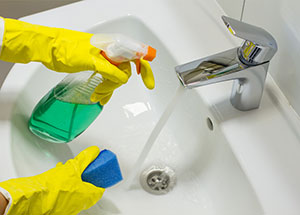6 Ways to Prevent Mold Growth
Photo: © Margostock - Dreamstime

Not only can mold result in expensive damage, but it releases spores that can pose a major health risk as well. By managing humidity and temperature, it is possible to deprive mold of the resources it needs to flourish, preventing mold growth and protecting your home. Below are some tried and true tips for dealing with mold before it takes hold:
1. Use a Dehumidifier
Mold grows rapidly at humidity levels above 55%, so anyone living in a particularly humid region would be wise to invest in a dehumidifier. In dryer climates, a dehumidifier can still be extremely useful in rooms where moisture accumulates, such as the bathroom, kitchen, and laundry room. Watch for classic signs of high humidity to determine whether you need a dehumidifier: condensation on walls, windows, or floors is a sure sign of a mold-friendly environment.
2. Provide Ventilation
Good air flow in the home is essential to preventing mold, especially when cooler weather sets in. Run bathroom and kitchen fans for an extra 10 minutes after you finish showering or cooking. In pleasant weather, opening a few windows will boost air circulation.
3. Clean Thoroughly
Mold tends to grow on organic surfaces or surfaces that have accumulated dust and grime. In fact, studies have shown that almost 80% of mold grows on dust, which makes regular vacuuming essential in homes with carpeting. For tile and hardwood, clean with anti-fungal and grease-fighting agents in order to stop the growth of mold.
4. Check for Leaks
Water leaks can be a major source of extensive mold damage. A damaged roof can cause water to build up behind drywall, where the mold will often go unnoticed until it is too late. Leaking pipes are another common culprit, so take the time to make an in-depth inspection of the home periodically. In cold climates, it may be necessary to insulate pipes in order to prevent them from cracking.
5. Use Mold-Resistant Products
Certain brands of house paint contain special mold inhibitors that can keep mold from growing, which can be especially useful in bathrooms and laundry rooms. For sinks and showers, consider applying a cured or urethane-based caulking agent. Many times, developers use silicone or latex-based caulks to save money, but these materials serve as a food source for mold. If you are planning on doing renovations in the future, it may be worthwhile to invest in special mold-resistant drywall and sheetrock.
6. Reduce Moisture Around the Foundation
If the soil around your home isn't sloped away from the foundation, mold growth is much more likely. Rainwater can seep into cracks in the foundation, which is especially problematic if the home has a basement or crawlspace. Sprinkler systems and crowded gutters can also contribute to excessive moisture around the foundation.
Once mold takes hold it can be virtually impossible to eradicate without expensive professional treatments and renovations. By using the tips above, any homeowner can take steps towards eliminating mold at its source.
